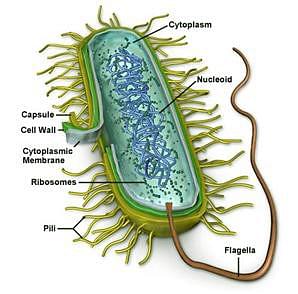Given below are two statements:
Statement I: Mycoplasma can pass through less than 1 micron filter size.
Statement II: Mycoplasma are bacteria with a cell wall.
In the light of the above statements, choose the most appropriate answer from the options given below:
Statement I: Mycoplasma can pass through less than 1 micron filter size.
Statement II: Mycoplasma are bacteria with a cell wall.
In the light of the above statements, choose the most appropriate answer from the options given below:
- Both statement I and Statement II are correct
- Both statement I and Statement II are incorrect
- Statement I is correct but statement II is incorrect
- Statement I is incorrect but statement II is correct
The Correct Option is C
Solution and Explanation
To determine the correctness of the statements, let's analyze each one:
Statement I: Mycoplasma can pass through less than 1 micron filter size.
Mycoplasmas are a type of bacteria known for lacking a cell wall, which makes them very small and flexible. They can indeed pass through filters with pore sizes less than 1 micron, a characteristic that distinguishes them from many other prokaryotes. Therefore, Statement I is correct.
Statement II: Mycoplasma are bacteria with a cell wall.
This statement is incorrect because a defining feature of mycoplasmas is that they lack a cell wall. This absence is what gives them high membrane flexibility and allows them to pass through small pores. Hence, Statement II is incorrect.
Considering the analysis of both statements, the correct choice is: Statement I is correct but statement II is incorrect.
Top Questions on The Tissue System
- Blood is a type of
- UPCATET - 2024
- Biology
- The Tissue System
- In which of the following connective tissues, the cells secrete fibres of collagen or elastin?
A. Cartilage
B. Done
C. Adipose tissue
D. Blood;E. Areolar tissue
Choose the most appropriate answer from the options given below :- NEET (UG) - 2024
- Biology
- The Tissue System
- Match List I with List II :Choose the correct answer from the options given below :
List - I List – II A. Squamous Epithelium i. Goblet cells of alimentary canal B. Ciliated Epithelium ii. Inner lining of pancreatic ducts C. Glandular Epithelium iii. Walls of blood vessels D. Compound Epithelium iv. Inner surface of Fallopian tubes - NEET (UG) - 2024
- Biology
- The Tissue System
- Which of the following is/are lateral meristems?
- IIT JAM BT - 2024
- Biology
- The Tissue System
- A cylindrical engineered tissue was developed with a diameter of 2 cm, height of 3 cm and Young's modulus of 20 MPa. If an axial tensile force of 10 N is applied, the percentage change in the height of the tissue is _______ %. Give your answer rounded off to 2 decimal places.
- GATE BM - 2024
- Human Anatomy and Physiology
- The Tissue System
Questions Asked in NEET exam
Three identical heat conducting rods are connected in series as shown in the figure. The rods on the sides have thermal conductivity 2K while that in the middle has thermal conductivity K. The left end of the combination is maintained at temperature 3T and the right end at T. The rods are thermally insulated from outside. In steady state, temperature at the left junction is \(T_1\) and that at the right junction is \(T_2\). The ratio \(T_1 / T_2\) is

- NEET (UG) - 2025
- Conductivity-thermal and electrical
- With the help of the given pedigree, find out the probability for the birth of a child having no disease and being a carrier (has the disease mutation in one allele of the gene) in the F3 generation.

- NEET (UG) - 2025
- Genetics
- Consider the diameter of a spherical object being measured with the help of a Vernier Callipers. Suppose its 10 Vernier Scale Divisions (V.S.D.) are equal to its 9 Main Scale Divisions (M.S.D.). The least count in the M.S. is 0.1 cm and the zero of V.S. is at -0.1 cm when the jaws of Vernier callipers are closed. If the main scale reading for the diameter is \(M = 5\) cm and the number of coinciding vernier division is 8, the measured diameter after zero error correction, is:
- NEET (UG) - 2025
- Measurement of length
- The plates of a parallel plate capacitor are separated by d. Two slabs of different dielectric constant \(K_1\) and \(K_2\) with thickness \(d/2\) and \(d/2\) respectively are inserted in the capacitor. Due to this, the capacitance becomes two times larger than when there is nothing between the plates. If \(K_1 = 1.25 K_2\), the value of \(K_2\) is :
- NEET (UG) - 2025
- Capacitors and Capacitance
- The correct order of the wavelength of light absorbed by the following complexes is:
A. $[ \text{Co(NH}_3\text{)}_6]^{3+}$
B. $[ \text{Co(CN)}_6]^{3-}$
C. $[ \text{Cu(H}_2\text{O)}_4]^{2+}$
D. $[ \text{Ti(H}_2\text{O)}_6]^{3+}$
Choose the correct answer from the options given below:- NEET (UG) - 2025
- Coordination chemistry
Concepts Used:
Kingdom Monera
Characteristics of Monera Kingdom
The organisms in this kingdom have the following characteristics: -
- Monerans are single-celled creatures.
- The cell wall is made up of peptidoglycan and is stiff.
- Binary fission is asexual reproduction.
- They have 70S ribosomes in them.
- The locomotory organ is the flagella.
- Organelles such as mitochondria, lys
- osomes, plastids, Golgi bodies, endoplasmic reticulum, centrosome, and others are not present.
- These are decomposers and mineralizers for the environment
